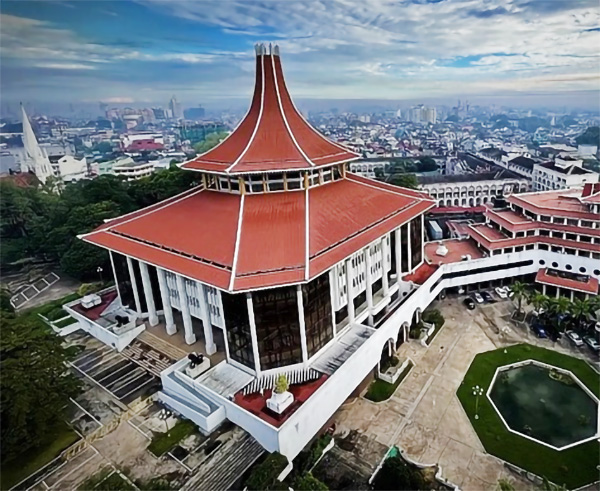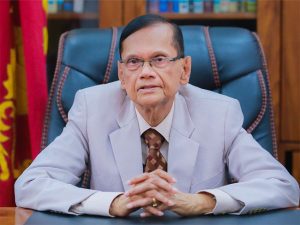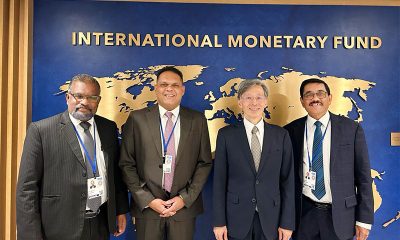Features
Inflation – Public Enemy Number One

[An article based on the Keynote Address delivered by Dr. P. Nandalal Weerasinghe, Governor of the Central Bank of Sri Lanka, recently at the Annual Research Symposium 2023 of the University of Colombo]
Introduction
Inflation affects every aspect of our lives; it is a force that shapes our purchasing power, influences our financial decisions, and impacts the overall stability of our society. In the year 2022, inflation reached extraordinary levels globally, driven by the lagged effects of ultra-easy monetary and fiscal support following the COVID-19 pandemic, supply shortages and capacity constraints, along with supply chain issues. Affected by global as well as domestic factors, Sri Lanka also experienced inflation at unprecedented levels in 2022. However, in late 2022, Sri Lanka entered an impressive disinflation path, eventually bringing inflation down to the targeted levels within a period of one year. Sri Lanka’s swift disinflationary process was supported by a combination of policy measures implemented by both the Central Bank and the Government.
In the forthcoming sections, I will delve into international experience and the academic outcomes on the causes and consequences of inflation; the role of monetary policy in coping with inflation; the dynamics of Sri Lanka’s high inflation episode; and the role of the Central Bank of Sri Lanka in managing inflation and inflation expectations, with special emphasis to the new Central Bank of Sri Lanka Act. A better understanding of the above could help shape academic research, which would also contribute towards effective policymaking and business decisions.
Declaring inflation as a public enemy
Inflation, a fundamental concept in economics, refers to the sustained increase in the general price level of goods and services in an economy over a period of time. When inflation occurs, each unit of currency buys fewer goods and services than it did before, leading to a decrease in the purchasing power of money. Over the years, economists and policymakers emphasised the seriousness and negative impact of inflation on the economy and people’s lives.
High inflation episodes have been a recurring phenomenon in economic history, causing significant challenges for nations and their citizens. It was in this context that Gerald Ford, the 38th president of the United States, even declared inflation as public enemy number one. In one of President Ford’s addresses to Congress in 1974 he stated “Only two of my predecessors have come in person to call upon Congress for a declaration of war, and I shall not do that. But I say to you with all sincerity that our inflation, our public enemy number one, will, unless whipped, destroy our country, our homes, our liberties, our property, and finally our national pride, as surely as any well-armed wartime enemy.” President Ford introduced the slogan “Whip Inflation Now (WIN)” as part of his campaign to fight inflation and even started wearing buttons with “WIN”. Although the outcome of this campaign is debatable, it illustrates how much of a problem inflation was in the 1970s.
Historical episodes of high inflation
Indeed, many countries have grappled with high inflation – and in some cases hyperinflation. One of the most infamous cases of hyperinflation occurred in Germany during the early 1920s. Following World War I, Germany experienced a severe economic crisis exacerbated by the reparations imposed by the Treaty of Versailles. The German government printed an excessive amount of money to meet its obligations, leading to hyperinflation. Prices skyrocketed, and people’s savings became worthless. At its peak, prices were doubling every few days, and workers were paid multiple times a day. Zimbabwe, in the late 2000s, faced hyperinflation due to a combination of economic mismanagement, land reforms, and political instability. The government printed money recklessly, causing prices to soar at an astronomical rate. At its peak, in mid-November 2008, Zimbabwe’s hyperinflation reached an astounding monthly rate of around 500 billion per cent (Moyo, 2023). The Zimbabwean dollar became practically worthless, and the country abandoned its own currency, relying on foreign currencies for transactions. Similarly, countries such as Argentina, Brazil and Venezuela experienced hyperinflation crises from time to time since the 1980s.
Why high inflation or hyperinflation is bad?
Inflation represents how much more expensive the relevant set of goods or services has become over a certain period, most commonly a year. To the extent that households’ nominal income does not increase as much as prices, they are worse off, because they can afford to purchase less. In other words, households’ purchasing power or real income (inflation-adjusted income) falls. Real income is a proxy for the standard of living. When real incomes are rising, so is the standard of living, and vice versa.
Savers and investors suffer significant losses during periods of high inflation. The real value of savings diminishes rapidly, while investors experience a decline in the real returns of their investments. Moreover, high inflation breeds uncertainty in the economy. Businesses face difficulties in planning for the future, unsure of their future costs and revenues. This uncertainty leads to reduced investments and hampers economic growth. Furthermore, nations experiencing high inflation find their international competitiveness severely compromised. As domestic prices rise, the cost of exports increases, making products less competitive in the global market. This situation can lead to trade imbalances and hinder economic recovery efforts, further exacerbating the challenges posed by high inflation.
Although high inflation hurts an economy, deflation, or falling prices, is not desirable either. When prices are falling, consumers delay making purchases if they can, anticipating lower prices in the future. For the economy, this means less economic activity, less income generated by producers, and lower economic growth. As you may know, Japan is one country with a long period of nearly no economic growth, largely because of deflation. Given the above, most economists now believe that low, stable, and most importantly predictable inflation is good for an economy. If inflation is low and predictable, it is easier to capture it in price-adjustment contracts and interest rates, reducing its distortionary impact.
What causes inflation?
Inflation could be influenced by numerous factors. Understanding these diverse causes of inflation is essential for academics as well as policymakers to recommend and implement appropriate measures to maintain stable prices and support sustainable economic growth. Demand-pull inflation occurs when the demand for goods and services exceeds their supply. When the demand outstrips supply, businesses often raise prices to maximise their profits. Cost-push inflation occurs when the cost to produce goods and services increases, leading businesses to pass these additional costs on to consumers in the form of higher prices. This can be caused by rising wages, increased costs of raw materials, or other production-related expenses. Expectations also play a key role in determining inflation. If people or firms anticipate higher prices, they build these expectations into wage negotiations and contractual price adjustments. To the extent that people base their expectations on the recent past (adaptive expectations), inflation would follow similar patterns over time, resulting in inflation inertia.
In the long run, inflation is primarily caused by factors related to the overall increase in the money supply in an economy relative to the growth in the real output of goods and services. If the money supply grows too big relative to the size of an economy, the unit value of the currency diminishes; in other words, its purchasing power falls and prices rise. Milton Friedman, a Nobel laureate in economics, argued that “inflation is always and everywhere a monetary phenomenon.” Friedman argued that changes in the money supply, driven by central bank policies and other monetary factors, are the primary drivers of inflation in the long run, while other factors can cause short-term fluctuations in prices. While Friedman’s insight into the monetary roots of inflation remains a fundamental principle, economists and policymakers now consider a broader array of factors when analysing inflationary trends. Modern economic analysis incorporates a more holistic approach, recognising the interplay of various elements in shaping inflationary outcomes.
How policymakers deal with inflation and the role of monetary policy
The policies aimed at reducing inflation depend to a great extent on the causes of inflation. If the economy has overheated and inflation is primarily demand-driven, central banks can implement contractionary monetary policy that rein in aggregate demand. Indeed, the central banks play a crucial role in controlling inflation through monetary policy.
One of the primary objectives of monetary policy, as emphasised by many central banks around the world, is maintaining price stability. Price stability is crucial for a healthy economy as it ensures that the purchasing power of a currency remains relatively constant over time. Economists have argued that stable prices create a favourable environment for long-term economic growth and investment (e.g., Mishkin, 2007). Moreover, monetary policy also plays a role in promoting economic growth. Studies by Romer (1993) and Barro and Sala-i-Martin (2004) suggest that stable monetary policies are positively correlated with long-term economic growth.
Central banks use a range of tools to influence the money supply and interest rates, affecting inflation. Traditional tools include policy interest rates, open market operations, and reserve requirements. Following the 2008 financial crisis, central banks implemented unconventional monetary policies, such as forward guidance, quantitative easing (asset purchasing) and negative interest rates. Furthermore, central bankers are increasingly relying on their ability to influence inflation expectations as an inflation-reduction tool. Policymakers announce their intention to keep economic activity low temporarily to bring down inflation, hoping to influence expectations. The more credibility central banks have, the greater the influence of their pronouncements on inflation expectations.
However, monetary policy is faced with increasing challenges and trade-offs. For example, the Phillips curve, which describes the inverse relationship between inflation and unemployment or output, has been the subject of extensive research. Studies that integrate monetary policy, inflation, and output stabilisation, have provided insights into the trade-offs faced by policymakers (e.g., Clarida, Gali, and Gertler, 1999) when achieving price stability. Furthermore, with increased globalisation, international factors can have a heightened impact on domestic inflation (e.g., Obstfeld and Rogoff, 2002). This sheds light on the complexities of maintaining price stability in a globalised world.
Across the globe, monetary policy frameworks cover various approaches, strategies, and models employed by central banks to achieve their objectives, such as price stability. Among those, inflation targeting has been a widely adopted monetary policy framework since the 1990s. Under inflation targeting, central banks set explicit inflation targets and use policy instruments to achieve them. Studies show that countries adopting inflation targeting are benefited in terms of providing clear objectives to the stakeholders and enhanced transparency (Bernanke, Laubach, Mishkin, and Posen, 1999). Many central banks have moved toward flexible inflation targeting, a special case of inflation targeting, which allows temporary deviations from the target to accommodate shocks to the real economy. Flexible inflation targeting has its advantages in terms of stabilising both inflation and the real economy (Svensson, 2010).
Global inflation in 2023
Despite the advances in monetary policy frameworks, across the globe, inflation accelerated to unprecedented levels during the year 2022. According to the IMF, global inflation accelerated to 8.7 per cent in 2022, from 4.7 per cent in the previous year, reflecting the impact of the lagged effects of ultra-easy monetary and fiscal support following the COVID-19 pandemic, shortages of fuel and nonfuel commodities exacerbated by the Russia-Ukraine conflict, and capacity constraints along with supply chain issues. Many countries allowed the passthrough of high global prices to the domestic economy, as administrative price-setting measures that are not cost-reflective usually result in the government’s accrual of large subsidy bills to compensate producers for their lost income.
However, in light of substantial monetary tightening by major central banks in the world, the resultant slowing of economic activity, easing supply chain disruptions, and moderating prices of energy and other commodities, inflation started to moderate in 2023. Nonetheless, the forecast levels of inflation in 2023 and 2024 are still higher than the pre-pandemic (2017–2019) levels of around 3.5 per cent. Moreover, the underlying price pressures are proving sticky, with labour markets tight in several economies. Therefore, core (underlying) inflation is likely to decline more slowly in the period ahead. Further, with rising geopolitical tensions in the Middle East, upside risks to global inflation are on the rise.
Sri Lanka’s economic crisis and the rise in inflation
In 2022, Sri Lanka experienced its worst-ever economic crisis, which had been in the making for many years, triggered by policy errors and exacerbated by other exogenous factors. Failure to build fiscal and external buffers over time made the nation vulnerable to domestic and external shocks, and the COVID-19 pandemic and the related shocks exposed the vulnerabilities in the Sri Lankan economy, bringing about the worst economic crisis in Sri Lanka’s history. The resultant economic hardship led to public anxiety and political upheavals.
By early 2022, the economy faced severe challenges due to an unsustainable macroeconomic model along with persistent budget deficits and external account imbalances. These issues, influenced by global and domestic factors, had depleted the economy’s foreign reserves. As a result, the country experienced intense pressure on its balance of payments (BOP), leading to a shortage of foreign exchange, a weakened exchange rate, soaring inflation, and reduced economic activity.
Although Sri Lanka managed to have single-digit inflation for over 12 years since 2009, inflation rose to historically high levels in 2022 stemming from global oil and other commodity price hikes, adjustments to domestic administrative prices, domestic supply disruptions, the substantial depreciation of the Sri Lanka rupee against the US dollar and the lagged effects of extended period of relaxed monetary policy following the COVID-19 pandemic. Contrary to the co-movement in inflation and economic growth in regular business cycles, Sri Lanka witnessed inflation and economic growth moving in opposite directions, as supply, as well as demand-driven inflation, accelerated overall inflation and economic growth stalled.
Measures taken to overcome the sharp rise in inflation
Several policy measures have been taken by the Central Bank to stabilise the economy and tighten monetary and credit conditions. With a view to countering rising inflationary pressures and anchoring inflation expectations, the Central Bank tightened monetary policy significantly since August 2021, with a significant increase in policy interest rates happening in April 2022. Monetary policy had to be conducted with an unprecedented level of deliberations, as the country entered a phase of high inflation and economic stagnation and tightening of monetary conditions will not only result in a reduction in inflation, but also economic growth. In parallel, the Central Bank also implemented a series of policy measures aimed at maintaining external sector stability and reducing import demand.
Since the beginning of the monetary tightening cycle in August 2021, the Central Bank’s key policy interest rates, i.e., Standing Deposit Facility Rate (SDFR) and Standing Lending Facility Rate (SLFR), were raised by 11 percentage points till March 2023. Furthermore, during this tightening phase, the Central Bank increased the Statutory Reserve Ratio (SRR) by 2 percentage points, while several caps on interest rates were removed, allowing for greater upward adjustments in market interest rates. The unprecedented upward adjustment of policy interest rates helped arrest the further build-up of demand-driven inflationary pressures, thereby pre-empting the escalation of adverse inflationary expectations, easing the pressure on the external sector, and correcting anomalies observed in the market interest rate structure.
(To be continued)
Features
How the ‘Lost Tribes of Israel’ help in understanding Mid-East peace issues

 Reports that the Israeli authorities have given the ‘go ahead’ for the repatriation and integration into the Israeli populace of some survivors in parts of India from what are described as the ‘Lost Tribes of Israel’, bring up a subject that merits continuous and focused research. The contemporary observer of international politics seeking to understand more thoroughly the factors fueling the Middle East conflict and the crucial role identity issues play in it would, no doubt, be the biggest beneficiary of such research.
Reports that the Israeli authorities have given the ‘go ahead’ for the repatriation and integration into the Israeli populace of some survivors in parts of India from what are described as the ‘Lost Tribes of Israel’, bring up a subject that merits continuous and focused research. The contemporary observer of international politics seeking to understand more thoroughly the factors fueling the Middle East conflict and the crucial role identity issues play in it would, no doubt, be the biggest beneficiary of such research.
In the global South in general there has hitherto been a tendency to soft peddle what may be called ‘the Israeli side of the story’. While the situation of the Palestinians has generated wide-spread empathy for them and very rightly so, an understanding of the causes prompting the Israelis to think and act as they do has gone comparatively unaddressed. This is a glaring lacuna in Southern scholarship in particular on the Middle East question. But if the international community is to pave the way for even a measure of reconciliation in the region the points of view of both sides to the conflict need to be more thoroughly understood.
A news report on page 3 of this newspaper on December 12, 2025 titled, ‘ Israel is moving Lost Tribe Jews from India’, is compulsory reading for those seeking to understand the history of Israel in its essentials. Going by Biblical History in particular the stark truth is that the Israelis were as persecuted as the Palestinians. It could be said that this process began in ancient times even before the birth of Jesus Christ a little over 2000 years ago.
The Old Testament of the Bible is essential reading for an understanding of the history of the Israelis, who are also referred to as ‘The Chosen People of God’. It is a history replete with persecution, mind-numbing war and suffering. The Israelis were continually harassed, subjected to extreme suffering and were displaced from the land they were settled in; which roughly corresponds to today’s Palestinian territories.
The Books of the Old Testament tell us that right through ancient times the Jews, today’s Israelis, suffered displacement, particularly at the hands of the then regional powers, Egypt, Persia and Assyria, and were taken captive to the lands of the conquerors or were reduced to slavery in their own territories. Consequently, displaced Jews escaped to the most distant parts of the world. This is how they happened to be in India as well. However, the fact to note is that the Jews were at one time a settled community with territories of their own.
What is exemplary about the Israeli or Zionist state that was established in 1948, under the overlordship of the old imperial powers, such as Britain, is that it invited the Jews spread virtually all over the world to return to their homeland, the Zionist state. Accordingly, as the report of December 12 reveals, the remnants of the Jewish tribes in India, for example, numbering some 5,800 persons, are being taken back to Israel from India’s Mizoram and Manipur states. Also of note is the fact that the Jews were originally members of 12 tribes, which figure thought-provokingly corresponds to Jesus’ 12 apostles.
According to the news report, these repatriation moves by the Israeli state are not bereft of some strategic motives, such as the strengthening of the Israeli presence in areas bordering Lebanon, for example, which are seen as vulnerable to Hizbollah attacks. The repatriation moves are also interpreted as part of efforts to ‘Judaize’ the Galilean region in particular with a view to reducing the Arab-Islamic presence there, since these areas are also home to a considerable number of Arabs. Since the possibility of friction between the Israeli settlers from India and the Arabs cannot be ruled out, we could very well be seeing the prelude to stepped-up ethnic cleansing exercises by the Israeli state in these security-sensitive border areas.
The larger problem for the international community, given this backdrop, is ‘ where we could go from here’ with regard to making forward moves towards realizing even a measure of peace and reconciliation in the Middle East. The Israeli state is doing well to open its doors to the returning Jewish diaspora readily but given the current power configurations in Israel, transitioning to Middle East peace could remain a distant prospect.
To ascertain why peace remains elusive in the region one would need to factor in that the Netanyahu regime in Israel is of a Far Right orientation. Such regimes usually keep countries internally divided and virtually at war with themselves by exploiting to their advantage, among other things, identity issues. The settlement of persons hailing from ‘Lost Israeli Tribes’ in security-sensitive regions offers the Netanyahu regime the latest opportunity to pit one community against the other in these regions and thereby consolidate its influence and power over the Jewish majority in Israel.
Ethnic-cleansing exercises orchestrated by the Israeli centre take this process to a ‘new high’ and are based on the same destructive reasoning. Basically, the underlying logic is that the Jewish nation is under constant attack by its rivals and should be on a constant war footing with the latter.
Unfortunately the US is at present not doing anything constructive or concrete to further the cause of a fair Middle East peace. Its peace effort in the region has, to all intents and purpose, run aground; presuming that the US was, indeed, intent on pursuing a Middle East settlement. Nor is the US bringing pressure to bear on Israel to make some headway towards some sort of solution. In the absence of these essential factors the Middle East is bound to remain in a state of war.
While it ought to be granted that the Jews have a long history of persecution and victimization, the Israeli state is not doing its citizens any good by keeping these harrowing memories alive for the purpose of power-aggrandizement and by following a policy of pitting one community against the other. While the Jewish legacy of victimhood needs to be abandoned, the Jewish people would be doing themselves immense good by guarding against voting into office Right wing governments that thrive on the ruthless exploitation of identity issues.
Features
Presidential authority in times of emergency:A contemporary appraisal

Keynote Address Delivered at the International Research Conference of the Faculty of Law, University of Colombo, on 12 December 2025.
1. The Policy Dilemma
One of the great challenges of modern public law is to reconcile traditional principles relating to the rule of law and the separation of powers with the exigencies of crises which threaten the destruction of society itself. To what extent must protective mechanisms developed by systems of law over the ages give way to the need for physical survival in the throes of life-threatening crises? What is the right balance to be struck, as a matter of public policy?
The classic statement is by John Locke, who insisted that, in emergencies, the government should have legally unfettered power “to act according to discretion, for the public good, without the prescription of the law, and sometimes even against it” (Second Treatise of Government). This is an ancient idea which goes back to Roman times, when Cicero, in his famous oration, Pro Milone, declared: “Inter arma silent leges” (“Amid the clash of arms, the laws are silent”).
This received expression in the present century in the work of Carl Schmitt, who insisted that “The sovereign is he who decides on the state of exception” (Political Theology:Four Chapters on the Concept of Sovereignty). According to him, not only is the sovereign’s authority untrammelled during emergency, but the declaration of emergency is his right alone, dependent solely on the exercise of his subjective judgment. This unqualified power springs from the supreme law of nature—-the safety of the people.
Judicial pronouncements across the world explicitly reflect this point of view. Justice Story, on behalf of the Supreme Court of the United States, famously declared: “The question arises, by whom is the exigency to be judged and decided? We are all of opinion that the authority to decide whether the exigency has arisen, belongs exclusively to the President, and that his decision is conclusive upon all other persons” (Martin v. Mott).In Ghulam Sarwar v. Union of India, Subba Rao CJ, speaking for the Supreme Court of India, observed: “The question whether there is grave emergency is left to the satisfaction of the Executive, for it is obviously in the best position to judge the situation”.
There is, however, equally emphatic opinion to the contrary. Khanna J, in a celebrated dissent, was scathing in his denunciation of the opposite approach: “The position would be that, so far as executive officers are concerned, in matters relating to life and personal liberty of citizens, they would not be governed by any law, they would not be answerable to any court, and they would be wielding more or less despotic powers” (Additional District Magistrate, Jabalpur v. Shivakant Shukla).
These competing postulates have been articulated with equal passion.
II. A Landmark Pronouncement by the Supreme Court of Sri Lanka
The Supreme Court of Sri Lanka had recently to deal with this issue frontally (Ambika Satkunanathan v. Attorney General). This is a watershed decision because, for the first time in our legal history, the Supreme Court held that an Acting President of the Republic had violated the fundamental rights of the People, enshrined in the Constitution, by the declaration of a State of Emergency.
The circumstances against the backdrop of which this historic ruling was made, are well known. A serious depletion of foreign reserves resulted in a severe shortage of basic amenities like fuel, cooking gas, electricity, staple food items, and medicine. In the context of an unprecedented default in the repayment of foreign loans and significant depreciation of the rupee, extended power cuts and galloping inflation led to acute economic hardship. These circumstances culminated in unrest on a scale never seen before on the Island.
Violence included the brutal murder of a Member of Parliament, the torching of residences of the Prime Minister and more than 70 other political personalities, forcible occupation of the Presidential Secretariat, the President’s official residence and the Office of the Prime Minister, with almost a million people gathered in Colombo demanding the resignation of the President. The elected President had fled the country, and a date had been set for an urgent meeting of Parliament to elect the President in accordance with procedure spelt out in the Constitution. An unruly mob had encircled Parliament, threatening to prevent this meeting from taking place. This was the situation in which Acting President Ranil Wickemesinghe declared a State of Emergency.
He did so in terms of provision in the Public Security Ordinance, which empowered him to take this action, if he was of opinion that this was “expedient in the interests of public security and the preservation of public order, or for the maintenance of supplies and services essential to the life of the community”(section 2).
The decision was that of a divided Supreme Court. The majority consisted of Murdu Fernando CJ and Yasantha Kodagoda J, while there was a vigorous dissent by Arjuna Obeyesekere J. The minority held that the circumstances warranted the opinion entertained by the Acting President, while the plurality declared themselves prepared to make this assumption. This, then, was common ground. The difference of opinion pertained to another vital issue.
Once the Acting President (hereinafter referred to as the President), had reached this conclusion, he had four optional courses of action available to him:
(i) He could have recourse to the routine law, principally the provisions of the Penal Code and the Criminal Procedure Code, to deal with the situation;
(ii) He could invoke Part III of the Public Security Ordinance, which would enable him to take particular actions such as calling out the Armed Forces to supplement the Police, prevent public gatherings on highways and in the vicinity of bridges and other specified locations, and declare curfew. These measures could be taken, short of proclamation of a State of Emergency;
(iii) He could take the “drastic step”, under Part II of the Public Security Ordinance, to bring into force the provisions contained within that section, in terms of which an Emergency could be declared, applicable to the whole Island;
(iv) While declaring an Emergency under Part II, he could confine its operation to particular parts of the Island.
This is where the difference of opinion between the plurality and the minority of the court manifested itself. The majority was of opinion that the President’s satisfaction relating to the existence of objective conditions justifying declaration of Emergency did not automatically entitle him to go the full length of bringing into being a nationwide Emergency under Part II, but obligated him further to consider whether measures of a more limited nature, contemplated by Part III, would be sufficient to deal effectively with the situation.Failure to do so, according to their ruling, would involve a breach of the Constitution.
By contrast, the minority was convinced that “Once the President has come to the conclusion that a state of public emergency exists, there is no purpose in mandating a consideration of other options”, and that “Requiring the President to embark on whether the ordinary laws or other various provisions or options would be adequate to deal with a public or national emergency, would be unreasonable and an unprecedented step”. On this basis, the minority held that the President’s actions were entirely within the Constitution, and entailed no liability for contravention of fundamental rights.
A great deal hinged, in practical terms,
on the divergence between these points of view.
III. Categories of Emergency: Uniform or Disparate Rules?
Contemporary trends in the law acknowledge marked differences in scale, intensity, and duration among types of emergency which precipitate varying degrees of government paralysis.
South African law incorporates one comprehensive definition of a State of Emergency, capable of invocation when “the life of the nation is threatened by war, invasion, general insurrection, disorder, natural disaster, or other public emergency” (Constitution, Article 37(1)(a)). Preferable, by far, is the position under the Emergencies Act of Canada, which recognises four different kinds of emergencies— natural disasters, threats to public order, international emergencies, and states of war (Section 18(2)). This enables different degrees of Parliamentary scrutiny and control.
The Constitution of India provides another example of this approach. Article 352 envisages a threat to the security of India or any part of the country by reason of war, external aggression or armed rebellion, while Article 356 contemplates a failure of constitutional government in any Indian state, and the context of Article 360 is jeopardy to the financial stability or credit of India.
In the spectrum of gravity, peril to the very existence of the state, in the degree present in the Sri Lankan situation, attracts the highest concern. In circumstances of potential government breakdown, “facile distrust” is not the recommended counsel. The courts of India have cautioned that “When there is a crisis situation, it is necessary to trust the government with extraordinary powers in order to enable it to overcome such crisis” (Bhagvati J. in Shivakant Shukla).
Undue concern about a lawless situation, typified by unbridled executive power, is not realistic. Emergency legislation has rightly been characterized as “extra-legislative legislation”. Far from there being a legal vacuum, systems of law have furnished practical safeguards, while enabling public order to be maintained.
One of these is the imaginative “super-majority escalator” technique, characteristic of South African law. Only a simple majority of Parliament is required to approve a State of Emergency operative for a maximum period of 21 days, and to extend it up to 3 months. Beyond that, a 60% majority is compulsory for further extensions (Article 37). Here, then, is a successful reconciliation of competing objectives.
Article 16 of the Constitution of the Fifth Republic in France empowers the President to determine not only the sufficiency of conditions warranting the declaration of a State of Emergency, but also its appropriate duration. Restraints on Presidential power in France are weak because the President, although required to consult the Conseil Constitutionel (Constitutional Court), is not bound by its advisory opinion, in the event of contrary advice.
Relative amplitude of Presidential power in emergency situations in France has been justified by a prominent French jurist, François Saint-Bonnet, on the basis that the curtailment of emergency powers at the disposal of the Executive carries the risk of deprivation of the very tools which the government finds indispensable to combat the threat.
Germany’s Basic Law, although wary of emergency powers because of the harrowing experience of Article 48(2) of the Constitution of the Weimar Republic, which paved the way for the rise of Hitler, nevertheless does not balk at recognizing “internal emergencies” which enable intervention by the Executive, albeit subject to control by the Federal Parliament.
Constitutional provisions in different jurisdictions, irrespective of the approach selected, envisage substantial executive power in times of emergency, curtailed by surveillance on the part of the elected Legislature.
IV. Restraints on Judicial Intervention
The decided cases in many countries are replete with examples of indicia which concede to the Executive great latitude in these contexts. The recurring feature is the urging of restraint in the exercise of judicial review in keeping with a suitably benign construction, consistent with constitutional standards. This is reflected in unimpeachable academic authority, as well.
It has been insisted that executive decisions “should be taken seriously as a bona fide attempt to solve whatever social problem they set out to tackle”(Aileen Kavanagh).The caution has been administered that judges should exercise great caution before concluding that the government has violated constitutional rights(Prof. T. R. S. Allan) and,in public emergencies threatening the life of the nation, elected officials should be permitted “to err, if at all, on the side of safety”(Lord Bingham).The courts “should resist the temptation to substitute their own preferred solutions to questions of public policy”(Allan).
This is so, for a number of reasons. One of them is that the public authority is entitled to latitude because it has “a kind of responsibility to advance the public interest that a court does not have”(Brooke L.J.).This is reinforced by other considerations. For instance, possession of special expertise by the executive authority is an important factor.
The nature of the subject matter, for this very reason, has a vital bearing on the issue. Judges have been conscious that “the more political the question is, the more appropriate it will be for political resolution, and the less likely it is to be an appropriate matter for judicial decision”(Lord Bingham).
A responsible and representative system of democratic governance brings into sharp focus “the degree of democratic accountability of the original decision maker, and the extent to which other mechanisms of accountability may be available”(Murray Hunt).Basic values of constitutionalism identify Parliamentary controls as infinitely preferable, in this regard, to judicial intervention.
This has to do with the nature and legitimate confines of the judicial function. Mirza Beg J, speaking for the Supreme Court of India, has candidly conceded that “the judicial process suffers from inherent limitations”(Shivakant Shukla).This is essentially because a court “can neither have full and truthful information, nor the means to such information”(Chandrachud J in Shivakant Shukla),especially in respect of classified information.
An absolute imperative is that the distinction between judicial review and substitution of judgment must be scrupulously observed. Admittedly contextual, this principle is of overriding significance because it is “wrong to expect executive bodies to replicate the style of analysis adopted by courts in determining allegations of violation of rights”(T. R. S. Allan).
It is crucial for the rule of law that the dividing line between these two distinct functions should not become inadvertently blurred. It is not necessary for the public authority to address itself to the same legal arguments as the court(Court of Appeal of England in the Begum case),the judicial function being restricted by the consideration that “the court is usually concerned with whether the decision maker reached his decision in the right way, rather than whether he got what the court might think to be the right answer”(Lord Hoffmann).
The raison d’etre underpinning executive intervention in these extraordinary situations should be constantly borne in mind. The reality is the absence of a practical substitute. “Neither the legislature nor the judiciary is capable of swift, energetic action, which leaves the executive by default as the authoritative body”(David Dyzenhaus).For this inescapable reason, there has been constant emphasis that executive actors “should not be deterred from engaging in the very activity needed,and contemplated, to deal with the crisis”.
The overarching object of policy is the preservation of public confidence. “The faster and more effective the response, the smaller the overall damage to society, as a whole. The best way for government to respond to these fears is to do something large and dramatic to reassure the populace”(Bruce Ackerman).
The weight attaching to these elements of public policy is self-evident. (To be continued)
 By Professor G. L. Peiris
By Professor G. L. Peiris
D. Phil. (Oxford), Ph. D. (Sri Lanka); Rhodes Scholar,Quondam Visiting Fellow of the Universities of Oxford, Cambridge and London; Former Vice-Chancellor and Emeritus Professor of Law of the University of Colombo.
Features
90th Anniversary of LSSP and leftism in Sri Lanka

The Lanka Sama Samaja Party was formed on the 18th of December 1935. Its four leaders were Dr. N. M, Perera, Dr. Coivin R, de Silva, Philip Gunewardena and Leslie Goonewardene, who also became the General Secretary. (Prior to this, in 1933, the Wellawatte Mills strike first led to their getting together in action). It must be mentioned that The LSSP was the first properly constituted political party in the country. It was also the first genuine Left party and its political philosophy was based on Marxism-Leninism. It took the name ” Sama Samaja”, which means ” Equal Society”, as, at that time, the people in Sri Lanka were unfamiliar with the terms Socialism and Communism. It was quickly accepted by the people and, despite the use of state power and thuggery against the LSSP by the local capitalist class, backed by the British rulers, the Party rapidly gained popularity among the people. In the General Election of March 1936 Dr. N. M. Perera was elected to represent the Ruwanwella electorate and Philip Gunawardena the Avissawella electorate. Unfortunately, Dr. S. A. Wickramasinghe was unable to retain Akuressa, which he had won in the 1931 Election, and Leslie Goonewardene failed to win Panadura due to the use of caste and money unfairly against him. Leslie, throughout his political career, refrained from descending to such a low level of politics But the LSSP stand helped in the process of uniting and politicisation of the people which was necessary to generate the confidence of the people in their ability to win Complete Independence through the democratic process.
Throughout its history a major role in the success of the LSSP was its provision of support to the struggles of the working class to win its rights. Dr. N. M. Perera formed the Ceylon Federation of Labour and, as its President, he organised the trade union movement to focus on winning their genuine demands as a class. He negotiated with the employers and won many demands across the table, and resorted to strike action as a last resort. He won the respect of both employees and employers as a leader who did not misuse the trade unions for personal vendettas. He used Parliament in a responsible manner to fight on behalf of the workers, while informing the public who suffered as a result of the strikes that the demands were just, and winning their support as well. The LSSP unions have maintained these values and continue to serve the working class
The LSSP was aware of the problem of poverty leading to hunger as a major factor that affected the life of a majority of our people. A survey done at the MRI, about two years ago, showed that 63% of families had an income below the poverty line. They could not have three adequate meals per day. Some had two meals and others only one that met their nutritional needs. The children and mothers were particularly vulnerable. The malnutrition level in that study was 14.3%. But the situation appears to be worse now. The Suriyamal Movement led NM to one of the worst affected areas, Kegalle. The focus was on malaria eradication, but they had to also address the problem of poverty and hunger. Rice, dhal and coconut sambol were provided. NM came to be known as “Parippu Mahaththaya” as a result. The LSSP is reviving the Suriyamal Movement which has become an urgent need after the Climate Change. Any help will be welcome.
We celebrate Independence Day alone, but India also celebrates Republic Day. It is the latter that gave India sovereignty, without which independence is empty. They won it within three years, with Ambedkar drafting the Republican Constitution. The LSSP kept on pressing for it but the comprador capitalist class, led by the UNP, kept delaying as they were happy with Dominion status. The LSSP joined the SLFP and CP to form the coalition government, led by Sirimavo Bandaranaike, in 1970, and Dr. Colvin R. de Silva was made the Minister of Constitutional Affairs. He finally drafted the Republican Constitution in 1972. Sri Lanka took 24 years to do this and we can hold our heads up as we are now politically a truly independent sovereign nation. But we remain a poor underdeveloped country with widespread unemployment and underemployment, especially among the youth. The number of those in poverty is rising while the rich are becoming super rich. The rich/poor gap is widening and it may explode. It is sad to see that Sri Lanka is far away from the Welfare State that the LSSP, led by Dr. Perera, strove to build. As Minister of Finance, he kept the cost of living down, balanced the Budget and did not tax the poor. He had a high direct tax on those who could afford to pay this. Unlike now, the priority was given to use the limited forex to buy essential medicines,not luxury vehicles.
As Minister of Science and Technology, I started the Vidatha Movement to provide the technology and finance for Small and Medium Enterprises (SMEs) countrywide, one centre headed by a science graduate in each division. I am told that more than 50,000 entrepreneurs have emerged marketing their products sustainably. More than one thousand are exporting their products. I appeal to the NPP government to continue to support them. We must develop into an industrial nation if we are to emerge from poverty. I and the LSSP will give all support. By the way, our armed forces can defend our country. We do not need American forces.
by Prof. TISSA VITARANA
(Leader and General Secretary, LSSP)
-

 Features4 days ago
Features4 days agoWhy Sri Lanka Still Has No Doppler Radar – and Who Should Be Held Accountable
-

 Features6 days ago
Features6 days agoDitwah: A Country Tested, A People United
-

 News6 days ago
News6 days agoRs 1. 3 bn yahapalana building deal under investigation
-

 News12 hours ago
News12 hours agoPakistan hands over 200 tonnes of humanitarian aid to Lanka
-

 News12 hours ago
News12 hours agoPope fires broadside: ‘The Holy See won’t be a silent bystander to the grave disparities, injustices, and fundamental human rights violations’
-

 Business6 days ago
Business6 days agoFluctuating fortunes for bourse in the wake of selling pressure
-

 Opinion6 days ago
Opinion6 days agoComfort for some, death for others: The reality of climate change
-

 News6 days ago
News6 days agoFormer SAARC SG Esala Weerakoon calls for ‘South Asian Climate Compact’























